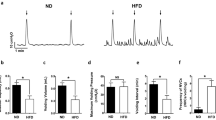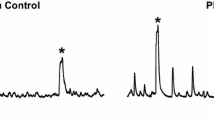Abstract
Increased excitability and contractility of detrusor smooth muscle (DSM) cells are associated with overactive bladder (OAB), which is often induced by obesity. Small-conductance Ca2+-activated K+ (SK) channels regulate the excitability and contractility of DSM cells. Selective pharmacological activation of SK channels attenuates hyperpolarization and the decreased relaxation effect in DSM cells in obesity-induced OAB. However, additional data are needed to confirm the regulatory effect of SK channels on the function of DSM cells in obesity-related OAB. The tested hypothesis was that activation of SK channels decreases modulation of DSM function in a rat model of obesity-related OAB. Female Sprague Dawley rats were fed a normal diet (ND) or a high-fat diet (HFD), weighed after 12 weeks, and subjected to urodynamic study, patch-clamp electrophysiology, and isometric tension recording. The average body weight and incidence of OAB were increased in the HFD group. Patch-clamp studies revealed that pharmacological activation of SK channels with SKA-31 had attenuated hyperpolarization of DSM cells. In addition, isometric tension recordings indicated that SKA-31 decreased relaxation of spontaneous phasic contractions of DSM strips in the HFD group. Attenuated function of SK channels increased the excitability and contractility of DSM cells, which contributed to the occurrence of OAB, suggesting that SK channels are potential therapeutic targets for control of OAB.





Similar content being viewed by others
Data availability
The datasets generated during and/or analysed during the current study are available from the corresponding author on reasonable request.
References
Afeli SA, Rovner ES, Petkov GV (2012) SK but not IK channels regulate human detrusor smooth muscle spontaneous and nerve-evoked contractions. Am J Physiol Renal Physiol 303(4):F559–F568
Andersson KE (2003) Storage and voiding symptoms: pathophysiologic aspects. Urology 62(5 Suppl 2):3–10
Andersson KE (2011) Antimuscarinic mechanisms and the overactive detrusor: an update. Eur Urol 59(3):377–386
Andersson KE (2016) Potential Future Pharmacological Treatment of Bladder Dysfunction. Basic Clin Pharmacol Toxicol 119(Suppl 3):75–85
Bunn F et al (2015) Is there a link between overactive bladder and the metabolic syndrome in women? A systematic review of observational studies. Int J Clin Pract 69(2):199–217
Deeks ED (2018) Mirabegron: A Review in Overactive Bladder Syndrome. Drugs 78(8):833–844
Ding H et al (2017) Treatment of obesity-associated overactive bladder by the phosphodiesterase type-4 inhibitor roflumilast. Int Urol Nephrol 49(10):1723–1730
Ding H et al (2017) Treatment of obesity-associated overactive bladder by the phosphodiesterase type-4 inhibitor roflumilast. Int Urol Nephrol
DiSanto ME et al (2003) Alteration in expression of myosin isoforms in detrusor smooth muscle following bladder outlet obstruction. Am J Physiol Cell Physiol 285(6):C1397–C1410
Gharaee-Kermani M et al (2013) Obesity-induced diabetes and lower urinary tract fibrosis promote urinary voiding dysfunction in a mouse model. Prostate 73(10):1123–1133
Hashitani H, Brading AF (2003) Electrical properties of detrusor smooth muscles from the pig and human urinary bladder. Br J Pharmacol 140(1):146–158
Herrera GM et al (2003) Urinary bladder instability induced by selective suppression of the murine small conductance calcium-activated potassium (SK3) channel. J Physiol 551(Pt 3):893–903
Hou J et al (2020) Attenuated regulatory function of the small-conductance Ca(2+)-activated K(+) channel in detrusor smooth muscle cells excitability in an obese rat model. Int Urol Nephrol
Li N et al (2016) Partial bladder outlet obstruction is associated with decreased expression and function of the small-conductance Ca2+-activated K+ channel in guinea pig detrusor smooth muscle. Int Urol Nephrol 49(1):17–26
Li N et al (2017a) Expression and function of the small-conductance Ca(2+)-activated K(+) channel is decreased in urinary bladder smooth muscle cells from female guinea pig with partial bladder outlet obstruction. Int Urol Nephrol 49(7):1147–1155
Li N et al (2017b) Partial bladder outlet obstruction is associated with decreased expression and function of the small-conductance Ca(2+)-activated K(+) channel in guinea pig detrusor smooth muscle. Int Urol Nephrol 49(1):17–26
Li N et al (2017c) Expression and function of the small-conductance Ca2+-activated K+ channel is decreased in urinary bladder smooth muscle cells from female guinea pig with partial bladder outlet obstruction. Int Urol Nephrol 49(7):1147–1155
Li N et al (2019a) Attenuated BK channel function promotes overactive bladder in a rat model of obesity. Aging (albany NY) 11(16):6199–6216
Li N et al (2019b) Effect of high-fat diet-induced obesity on the small-conductance Ca(2+)-activated K(+) channel function affecting the contractility of rat detrusor smooth muscle. Int Urol Nephrol 51(1):61–72
Marcelissen T et al (2019) Exploring the relation between obesity and urinary incontinence: Pathophysiology, clinical implications, and the effect of weight reduction, ICI-RS 2018. Neurourol Urodyn 38(Suppl 5):S18–S24
Murphy M, Robertson W, Oyebode O (2017) Obesity in International Migrant Populations. Curr Obes Rep 6(3):314–323
Parajuli SP et al (2012) Pharmacological activation of small conductance calcium-activated potassium channels with naphtho[1,2-d]thiazol-2-ylamine decreases guinea pig detrusor smooth muscle excitability and contractility. J Pharmacol Exp Ther 340(1):114–123
Parajuli SP et al (2013) NS309 decreases rat detrusor smooth muscle membrane potential and phasic contractions by activating SK3 channels. Br J Pharmacol 168(7):1611–1625
Parsons JK et al (2013) Obesity and benign prostatic hyperplasia: clinical connections, emerging etiological paradigms and future directions. J Urol 189(1 Suppl):S102–S106
Petkov GV (2011) Role of potassium ion channels in detrusor smooth muscle function and dysfunction. Nat Rev Urol 9(1):30–40
Petkov GV (2012) Role of potassium ion channels in detrusor smooth muscle function and dysfunction. Nat Rev Urol 9(1):30–40
Petkov GV (2014) Central role of the BK channel in urinary bladder smooth muscle physiology and pathophysiology. Am J Physiol Regul Integr Comp Physiol 307(6):R571–R584
Rahman NU et al (2007) An animal model to study lower urinary tract symptoms and erectile dysfunction: the hyperlipidaemic rat. BJU Int 100(3):658–663
Richter HE et al (2010) The impact of obesity on urinary incontinence symptoms, severity, urodynamic characteristics and quality of life. J Urol 183(2):622–628
Rohrmann S et al (2005) Association between markers of the metabolic syndrome and lower urinary tract symptoms in the Third National Health and Nutrition Examination Survey (NHANES III). Int J Obes (lond) 29(3):310–316
Sankaranarayanan A et al (2009) Naphtho[1,2-d]thiazol-2-ylamine (SKA-3.1), a new activator of KCa2 and KCa31 potassium channels, potentiates the endothelium-derived hyperpolarizing factor response and lowers blood pressure. Mol Pharmacol 75(2):281–95
Sarma AV et al (2009) Diabetes and benign prostatic hyperplasia/lower urinary tract symptoms–what do we know? J Urol 182(6 Suppl):S32–S37
Soder RP et al (2013) SK channel-selective opening by SKA-31 induces hyperpolarization and decreases contractility in human urinary bladder smooth muscle. Am J Physiol Regul Integr Comp Physiol 304(2):R155–R163
Thorneloe KS et al (2008) Small-conductance, Ca(2+) -activated K+ channel 2 is the key functional component of SK channels in mouse urinary bladder. Am J Physiol Regul Integr Comp Physiol 294(5):R1737–R1743
Wang Z et al (2012) Inhibition of TNF-alpha improves the bladder dysfunction that is associated with type 2 diabetes. Diabetes 61(8):2134–2145
Weisman A et al (2018) Evolving Trends in the Epidemiology, Risk Factors, and Prevention of Type 2 Diabetes: A Review. Can J Cardiol 34(5):552–564
Xin W et al (2014a) Constitutive PKA activity is essential for maintaining the excitability and contractility in guinea pig urinary bladder smooth muscle: role of the BK channel. Am J Physiol Cell Physiol 307(12):C1142–C1150
Xin W et al (2014b) BK channel-mediated relaxation of urinary bladder smooth muscle: a novel paradigm for phosphodiesterase type 4 regulation of bladder function. J Pharmacol Exp Ther 349(1):56–65
Xin W et al (2016) BK channel regulation by phosphodiesterase type 1: a novel signaling pathway controlling human detrusor smooth muscle function. Am J Physiol Renal Physiol 310(10):F994–F999
Author information
Authors and Affiliations
Corresponding author
Ethics declarations
Conflict of interest
The authors have no conflict of interest to declare.
Ethical approval
The protocols of all animal studies were conducted in accordance with all applicable international, national, and institutional guidelines for the care and use of laboratory animals.
Additional information
Publisher's Note
Springer Nature remains neutral with regard to jurisdictional claims in published maps and institutional affiliations.
Rights and permissions
About this article
Cite this article
Li, J., Liu, T., Li, N. et al. SKA-31-induced activation of small-conductance calcium-activated potassium channels decreased modulation of detrusor smooth muscle function in a rat model of obesity. J Bioenerg Biomembr 54, 135–144 (2022). https://doi.org/10.1007/s10863-022-09939-2
Received:
Accepted:
Published:
Issue Date:
DOI: https://doi.org/10.1007/s10863-022-09939-2




